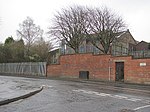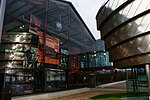Langloan railway station
1866 establishments in Scotland1964 disestablishments in ScotlandBeeching closures in ScotlandCoatbridgeDisused railway stations in North Lanarkshire ... and 5 more
Former Caledonian Railway stationsPages with no open date in Infobox stationRailway stations in Great Britain closed in 1964Railway stations in Great Britain opened in 1866Use British English from August 2020

Langloan railway station served the suburb of Langloan, North Lanarkshire, Scotland from 1866 from 1964 on the Rutherglen and Coatbridge Railway.
Excerpt from the Wikipedia article Langloan railway station (License: CC BY-SA 3.0, Authors, Images).Langloan railway station
Annerley Place,
Geographical coordinates (GPS) Address Nearby Places Show on map
Geographical coordinates (GPS)
| Latitude | Longitude |
|---|---|
| N 55.8538 ° | E -4.0426 ° |
Address
Annerley Place
Annerley Place
ML5 5LH , Langloan
Scotland, United Kingdom
Open on Google Maps








